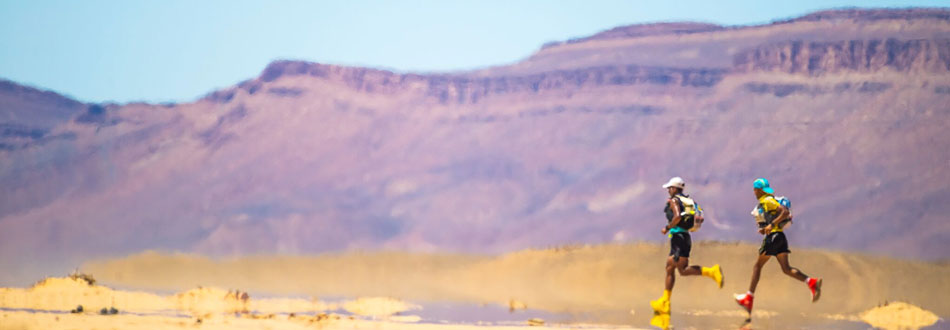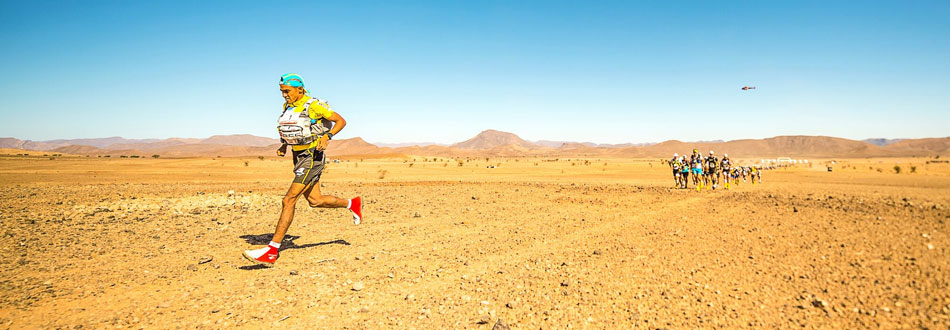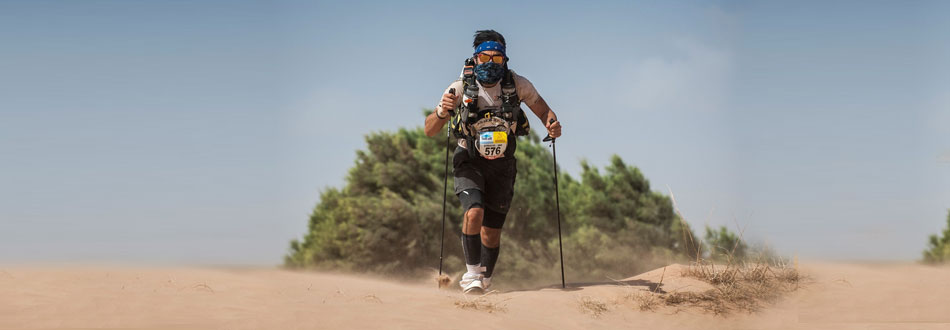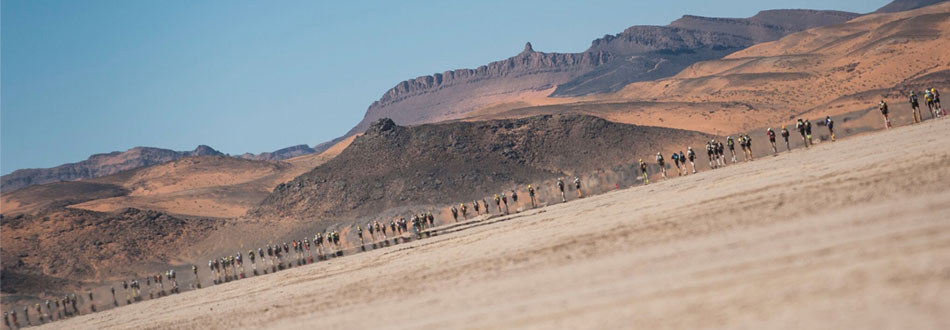COMPULSORY ITEMS
You will be penalized if you are unable to present the following items* at race check-in and/or during random searches over the course of the event. *Be sure to periodically check the official race website for updates/changes to the compulsory list.
|
Backpack
|
There are many great choices, but it’s best to find one that fits comfortably and go from there. Most competitors can fit all of the gear into a 25L or smaller pack. Look for options from: Raid Light; Ultimate Direction; OMM Classic 25L or Phantom 25L; Official MDS Pack (available through the race website); WAA MDS Pack; UltrAspire Fastpack; Hyperlite Packs; Six Moon Designs; Red Hawk Packs; etc. Before departing for Morocco, be sure to check that there are no rips or tears at all of the critical attachment points (shoulder straps, waist-belt, zippers, etc.)
|
|
|
2 x 750-800ml. water bottles
|
Some participants prefer to just carry the 1.5L water bottle handed out at each checkpoint. Others like to transfer the water from that 1.5 L bottle into 2 standard “bike” bottles and carry them in pouches attached to the front straps on the pack. Note: a bladder system can be difficult to use since it requires pack removal at each checkpoint…and, the newer ‘soft-flask’ bottles can rip or tear.
|
|
|
Sleeping bag
|
Western Mountaineering – Highlite; PHD Minim Ultra; Yeti Passion One; OMM 1.6 bag; etc.
|
|
|
Flashlight-Headlamp
|
Petzl Bindi; Petzl Actik Core; Petzl Zipka +, OR Petzl Zipka Plus 2; Black Diamond Spot 350; etc.
|
|
|
Extra batteries for light
|
Go for the lithium variety – they are lighter and last longer. Make sure you have the correct spare batteries for your chosen headlamp.
|
|
|
10 safety pins
|
1 medium; 4 small… 4 extra-small
|
|
|
Compass
|
With at least 2 degrees of precision! Go with the lightest option! | |
|
Lighter
|
Smallest one you can find – (no longer allowed as ‘carry-on’ items aboard aircraft but easily found in Morocco)
|
|
|
Knife
|
I use the Classic SD Swiss army knife because it includes scissors, which can be used to cut tape, trim labels, etc.
|
|
|
Topical disinfectant
|
Alcohol pads will suffice
|
|
|
Anti-venom pump
|
A “snake bite kit.” Options from Sawyer and Coghlans are most comm\on. I use the Sawyer version (which looks like a large syringe) and carry the pump & the smallest attachment (no need to carry the entire case).
|
|
|
Whistle
|
Very small, lightweight plastic; many whistles are built into the buckle of the pack’s sternum strap
|
|
|
Signaling Mirror
|
I only use a small round mirror, about the size of a large coin (US quarter)
|
|
|
Survival sheet
|
Like the emergency blankets handed out at marathon finish lines
|
|
|
Food for duration of race
|
You must have a minimum of 2000 calories per day, Check the race Regulations for details.
|
|
|
SPOT Tracker
|
**provided by AOI
|
|
|
Salt tablets
|
**provided by AOI
|
|
|
Light Stick for 50-mile stage
|
**provided by AOI
|
|
|
EKG – dated within 30 days of event
|
**must have original copy signed and stamped by a doctor!!
|
|
| 200 Euros (or equivalent in Dirhams) & Passport
Sunscreen |
**Must be carried in your pack for the duration of the race. (I store this inside my passport, which is kept inside a Ziploc bag.)
1 tube |
FOR THE MEDICAL FORM & ECG
VERY IMPORTANT! Your Doctor should note any medications you might be using before or during the event (especially asthma medication). There is random ‘doping’ control at the MDS because prize money is awarded to the top finishers, so you could receive a penalty if something shows up in their tests. The ECG must be dated no more than 30 days prior to the start of the race – make sure the original copy is signed and dated by your doctor.
SUGGESTED FOOD LIST
Remember that a good mix of food will keep you happy over the seven days. Eating the same meal or snacks everyday gets old quickly and you will need to eat to get through the event. Also, while the race takes place over seven days, you will not need a dinner after the last stage – after crossing the finish line, everyone will be given a box lunch, then board busses and return to the hotel for dinner.
**You might wish to bring along some extra food to eat before the race. While the organizers do provide meals at the bivouac, you might not like what is being served. So, it is a good idea to pack some extra freeze dried meals, tuna packs, peanut butter and jelly, etc.
**You should also include extra drink mix to consume while at the bivouac. You will be there for almost two days before the start of the race, and it will be HOT, so you will need to be hydrating.
| 7 -Breakfasts | I take a variety of things – bars, oatmeal, pop-tarts, instant noodles, etc | |
| 6- 7 During the stage (Lunch) | usually just gels, nuts, pretzels, chips, jerky, peanut butter packets, ginger chews, Clif Bloks, bars, etc. … and eat on the run. Go with what works best for you. | |
| 6 – Dinners | freeze dried meals… a good variety… you won’t need one for the last day… I let them cook in the sun | |
| Electrolyte drink mix | enough for each day… it helps to bring a variety so you don’t get sick of one flavor | |
| Recovery drink mix – one for after each stage | GU Recovery Mix or First Endurance Ultragen are good choices. | |
| Salt Stick or GU Salt Tabs (salt pills) for each stage | I bring my own (instead of relying on those provided by the organizers) and usually take 2-6 per hour, depending on what else you are taking on board through other food/drink options. | |
| Tea bags & Bouillon Cubes | Nice to have something like this to add flavor to the water |
SUGGESTED PERSONAL ITEMS
Following is our Suggested Packing List. There may be additional items that you wish to bring along but don’t appear on our list, so you should use this only as a guide. Please note that some of the items on the list are only “suggestions” while others are essential (like running shoes). Please don’t hesitate to ask us about other items that you are considering to bring along.
|
Painkillers**
|
Tylenol 8 hour, Aleve, etc.- **IMPORTANT: Be careful and make sure to do your research on the side effects of taking pain meds during exercise, especially in extreme heat! It’s best to avoid these!
|
|
Sleeping pills (optional)
|
Some people use these to get through the night. Consult a physician and be careful when taking any prescription meds, especially in this harsh environment
|
|
One pair of shorts
|
I use compression shorts as they tend to chafe less (and keep the sand out)
|
|
One race shirt
|
Numerous options to consider, but go with something that works for you: Smartwool microweight, Under Armor Heat Gear, Columbia OmniFreeze, etc.
|
|
Buff
|
Great piece of gear: can be used as a neck gaiter, washcloth, head warmer at night, etc.
|
|
Sunglasses and/or Goggles
|
A must have – try a pair Light Adjusting lenses (like Julbo) that have a foam seal around the eyes to keep out the sand
|
|
1 hand-held water bottle
|
optional, if you don’t want to attach bottles to shoulder straps or carry the 1.5L provided at each water stop.
|
|
Earplugs
|
Should be on the compulsory gear list!
|
|
Hat
|
I use a breathable running hat from Headsweats… some use one with a flap on the back to protect the neck from the sun
|
|
Extra shirt for after each stage (optional)
|
I typically bring a long-sleeve silk or wool shirt
|
|
1-4 pairs of socks
|
I use Smartwool… some folks prefer Injinji toe-socks and DryMax warm weather socks. I bring two pairs, but some get by with just one.)
|
|
Windbreaker (e.g. Montbell Tachyon) or Tyvec Suit
|
Weighs only a few grams/ounces and can keep you a bit warmer at night
|
|
Flipflops or lightweight slippers (optional)
|
If using, as lightweight & cheap as possible… toss them on the last morning.
|
|
Running shoes WITH Gaiters
|
Good options available from Hoka, Altra, Brooks, Salomon, etc. The gaiter must cover the entire shoe. Look for gaiter options from Raid Light, Rough Country, My Race Kit, etc. It’s best to attach Velcro, sewn (not glued) onto the shoe where the upper meets the outsole.
|
|
Sunscreen
|
I carry a small spray bottle and a Sun Bum SPF50 stick
|
|
Baby Wipes
|
1-2 per day for a daily bath – air dry ahead of time (to save weight) and rehydrate with water when needed
|
|
Lip balm (w. SPF)
|
One tube is enough; I’ve had good luck with Dermatone SPF30
|
|
Toilet paper
|
Better to have a little extra! Remember to pack extra for the first 2 days at the bivouac!
|
|
Hand sanitizer
|
Important to have enough for the week… especially as your body breaks down!
|
|
Extra needle for popping blisters
|
Nice to have if you wish to take care of your feet on your own. Can also use one of the mandatory safety pins
|
|
Blister remedies – for helping with/preventing or covering blisters (optional)
|
Options include: Blister Shield Powder, Trail Toes, Sport Slick, New Skin – Great stuff to help prevent and/or protect/heals blisters
|
|
Alcohol pads
|
Can be same as disinfectant in compulsory list (above)
|
|
Tiny toothbrush
|
As small as possible
|
|
Tiny tube of toothpaste
|
Again, as small as possible – squeeze some out to reduce weight
|
|
Q-tips (optional)
|
One for each day to remove sand from ears
|
|
Deodorant (optional)
|
A small, travel tube (not mandatory, but it does help)
|
|
Blister Kit (optional)
|
Personal preference (as above)
|
|
Medical tape (optional)
|
Budget enough to get you through the week
|
|
Anti-inflammatory pills
|
Again, be extremely careful with these…use only if needed and try to avoid!
|
|
Antacid (optional)
|
If needed. |
|
Multi-purpose soap (optional)
|
For bathing, cleaning utensils and clothing
|
|
Vitamins (optional)
|
Not required, but if you take them regularly at home, could be helpful
|
|
Small brush/comb (optional)
|
To look pretty for the camera
|
|
Camera (optional)
|
A weatherproof,digital versions is best- fyi… the sand is unforgiving and can destroy cell phones (and remember, it’s not possible to recharge batteries at the bivouac).
|
|
Spork
|
don’t skimp on this… if yours breaks, you’ll be begging others to use theirs!
|
|
Music Player (optional)
|
Sometimes helps the miles pass a bit faster
|
|
Extra batteries
|
Again, lithium are best
|
|
Pencil & notebook (optional)
|
If you want to keep a journal , but you can also make notes in the provided Road Book
|
|
Book (optional)
|
You can rip out the pages as you go along… or work it out to share with another competitor.
|
|
Sleeping pad (optional)
|
Lightweight foam… discard on last day; keeps some of the rocks from digging into your back/hips and can make the nights pass a bit quicker as you’ll be warmer.
|
**Pre-Race Check-in & Registration: Your bag with the extra clothing and gear that you will not use during the race MUST be brought with you to the pre-race check-in during your allotted time. You will find it is easier if you bring only ONE extra bag with you (in addition to your race pack). It can be quite a long walk from your tent to the check-in tents with all that gear. You also might want to bring along a lock for the bag you’ll be checking… chances are nothing will happen, but it is better to be safe, especially if you plan on storing a wallet, airline tickets, etc. in that bag.
**Please note… we highly recommend that you plan on taking all of your necessary race gear as “carry-on” luggage. That is, from our experience, we think it’s wise to pack all of your actual race gear in one bag that is small enough to carry on board the airplane with you for the trip to Morocco. You do not want to take a chance of the airline misplacing your luggage before the event. (This happened to a good friend of ours and his luggage was returned to him… in July!)
**You will need to carry your passport with you during the actual race (just in case you need to depart before the race ends); it’s required for race check-in at the bivouac.







